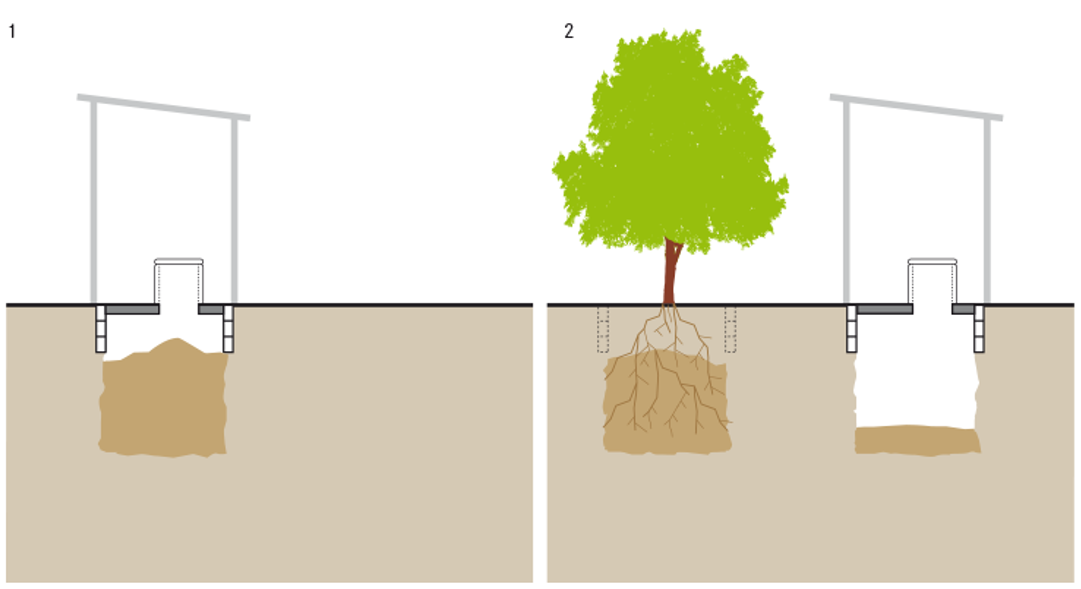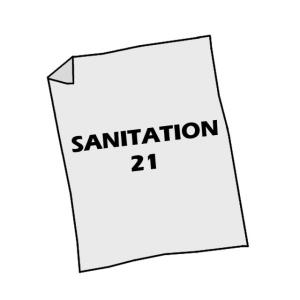To decommission a pit, it can simply be filled with soil and covered. Although there is no received benefit, the full pit poses no immediate health risk and the contents will degrade naturally over time. Alternatively, the Arborloo is a shallow pit that is filled with excreta and soil/ash and then covered with soil; a tree planted on top of the nutrient-rich pit will vigorously grow.
| In | Out |
|---|---|
Compost / Biosolids |
When a single pit or a single VIP is full and cannot be emptied, "fill and cover", i.e., filling the remainder of the pit and covering it is an option, albeit one with limited benefits to the environment and the user.
The Arborloo is a shallow pit on which a tree can be planted after it is full, while the superstructure, ring beam and slab are moved to a new pit. Before the Arborloo is used, a layer of leaves is put on the bottom of the empty pit. A cup of soil, ash or a mixture of the two should be dumped into the pit to cover excreta after each defecation. If they are available, leaves can also occasionally be added to improve the porosity and air content of the pile. When the pit is full (usually every 6 to 12 months), the top 15 cm is filled with soil and a tree is planted. Banana, papaya and guava trees (among many) have all proven to be successful.

An Arborloo is only an option if the site is suitable for a tree to grow. Therefore, when selecting the pit location, users should already take the space and site conditions required for a new tree into account (e.g., distance to houses).
A shallow pit, about 1 m deep, is needed for an Arborloo. It should not be lined as any lining would prevent the tree or plant from properly growing.
A tree should not be planted, however, directly in the raw excreta. It should be planted in the soil on top of the pit, allowing its roots to penetrate the pit contents as it grows. It may be best to wait for the rainy season before planting it if water is scarce.
There is minimal risk of infection if the pit is properly covered and clearly marked. It may be preferable to cover the pit and to plant a tree rather than emptying it, especially if there is no appropriate technology available to remove and treat the faecal sludge.
Users do not come in contact with the faecal material and, thus, there is a very low risk of pathogen transmission.
Arborloo demonstration projects that allow for the participation of community members are useful ways to display the ease of the system, its inoffensive nature, and the nutrient value of human excreta.
A cup of soil and/or ash should be added to the pit after each defecation and leaves should be periodically added. Also, the contents of the pit should be periodically levelled to prevent a cone shape from forming in the middle.
There is little maintenance associated with a closed pit other than taking care of the tree or plant. Trees planted in abandoned pits should be regularly watered. A small fence of sticks and sacks should be constructed around the sapling to protect it from animals.
Filling and covering a pit is an adequate solution when emptying is not possible and when there is space to continuously dig new pits.
The Arborloo can be applied in rural, peri-urban, and even denser areas if enough space is available.
Planting a tree in the abandoned pit is a good way to reforest an area, provide a sustainable source of fresh fruit and prevent people from falling into old pit sites.
Other plants such as tomatoes and pumpkins can also be planted on top of the pit if trees are not available.
Depending on the local conditions, however, the content of a covered pit or Arborloo could contaminate groundwater resources until it is entirely decomposed.
Rapid Assessment of CRS Experience With Arborloos in East Africa
This rapid assessment reviewed sanitation activities by Catholic Relief Services in East Africa, in particular the promotion of the Arborloo – an innovative latrine designed to help achieve sustainable and scalable sanitation improvements in rural Ethiopia, South Sudan, Kenya and Uganda. The assessment explored the factors affecting Arborloo acceptance and sustainability, the scope and approaches for scaling up the latrine in these countries and in Tanzania, as well as opportunities to foster links between community and school sanitation.
HERBERT, P. (2010): Rapid Assessment of CRS Experience With Arborloos in East Africa. Baltimore: Catholic Relief Service URL [Accessed: 09.01.2019]An Ecological Approach to Sanitation in Africa
This book is about ways of building and managing the various simple eco-toilets designs. It discusses the important subject of using the recycled materials in agriculture with the help of many working examples.
Morgan, P. (2014): An Ecological Approach to Sanitation in Africa. A Compilation of Experiences. Harare: Aquamor URL [Accessed: 09.05.2019]Toilets That Make Compost
This book describes in an easy-to-understand and picture-based way how to construct three different low cost sanitation solutions, namely arborloos, fossa alterna and urine diversion toilets.
MORGAN, P. EcoSanRes (2007): Toilets That Make Compost . Stockholm: Stockholm Environment Institute URL [Accessed: 09.05.2019]Ecological Toilets
This book describes how to construct Arborloo toilets and how it can be upgraded to VIPs at a later stage.
MORGAN, P. EcoSanRes (2009): Ecological Toilets. (pdf presentation). Stockholm: Stockholm Environment Institute URL [Accessed: 09.05.2019]Smart Sanitation Solutions
Smart Sanitation Solutions presents examples of low-cost household and community-based sanitation solutions that have proven effective and affordable. A wide range of innovative technologies for toilets, collection, transportation, treatment and use of sanitation products that have already helped thousands of poor families to improve their lives is illustrated.
NWP (2006): Smart Sanitation Solutions. Examples of innovative, low-cost technologies for toilets, collection, transportation, treatment and use of sanitation products. (= Smart water solutions ). Amsterdam: Netherlands Water Partnership (NWP) URL [Accessed: 09.05.2019]











